| Designation: | LAV-150 |
 |
|---|---|---|
| Manufacturer: | MMC Engineering Services Sdn | |
| Product type: | Armoured Vehicles | |
| Name: | Modernization of the vehicle |
In 1962 the then Cadillac Gage Company developed, as a private venture, a 4 × 4 light armoured vehicle which could be used for a wide range of battlefield missions such as armoured personnel carrier, weapons platform and reconnaissance vehicle.
The first prototype of this vehicle, called the V-100 Commando, was completed in 1963, with first production vehicles being completed the following year.
The V-100 was widely used in Vietnam for both convoy escort work and for patrolling airbases and other high-value targets. The V-100 was powered by a Chrysler 361 V-8 petrol engine which developed 200 hp and gave the vehicle a maximum road speed of 100 km/h. Gross vehicle weight was 7,370 kg and a maximum of 12 men including the crew could be carried.
The V-100 was supplemented in production by the larger V-200, which was powered by a Chrysler 440 CID petrol engine which developed 275 hp and gave the vehicle a maximum road speed of 96 km/h. Gross vehicle weight of the V-200 was 12,730 kg. The V-200 was sold only to Singapore and is no longer being produced. Versions of the V-200 used by Singapore include: anti-aircraft, with the Swedish SAAB Bofors Dynamics RBS 70 surface-to-air missile system; recovery, fitted with an A-frame at the front of the hull; fire support, fitted with a two-man turret armed with a 90 mm MECAR gun with 7.62 mm coaxial and 7.62 mm anti-aircraft machine guns; and APC, fitted with a two-man turret armed with a 20 mm Oerlikon Contraves cannon, 7.62 mm coaxial and 7.62 mm anti-aircraft machine guns. Cadillac Gage submitted their final proposal for the larger V-200 in April 1968, with the first prototype being completed and ready for trials in April 1969. First batch of V-200 vehicles were delivered to Singapore in July 1970.
There is a separate entry for the more recent LAV-300 (6 × 6) armoured vehicle range. This was developed specifically for the export market and is offered with a similar range of turrets as the latest LAV-150 ST family of vehicles.
In 1984, Kuwait placed an order for 20 V-150 S Commandos and 60 V-300 Commandos. It is believed that all of these were lost during the Iraqi invasion of Kuwait in August 1990.
In 1985, Cadillac Gage announced that production of the V-150 was to cease and that it would be replaced in production by the V-150 S.
In August 1988, US Army Tank Automotive Command placed an order with Cadillac Gage Textron for 14 V-150 S vehicles, at a cost of USD7.014 million, with another 10 ordered in December 1988 at a cost of USD3.113 million.
In 1992, Turkey ordered a total of 124 V-150 S 4 × 4 APCs with first deliveries being made late in 1992.
The first order was for 50 vehicles valued at USD14 million and fitted with turrets, and the second order for 74 vehicles valued at USD25.6 million, 20 of which were supplied in water cannon configuration, 10 are APCs with turrets and 44 standard APCs.
In 1994, Cadillac Gage Textron became part of Textron Marine & Land Systems and the V-150 series was renamed the LAV-150 family. In the following description and variants, the current LAV-150 designation is used.
Production of the LAV-150 was undertaken at the Cadillac Gage Textron facility in Coco, Florida, but production was then undertaken at the new Textron Marine & Land Systems facility in New Orleans, Louisiana.
In mid-1995, it was announced that the US Army Tank-automotive and Armaments Command had awarded the company a contract worth USD2 million for the supply of five LAV-150 ST light armoured vehicles for an undisclosed country in Asia.
By late 2005, total production of the LAV-100/LAV-150/LAV-200 series and variants, amounted to over 3,000 vehicles.
With the type classification of the Cadillac Gage ASV 150 by the US Army in March 1999 and the placing of a five-year production contract, the LAV-150 has been phased out of production. Details of the ASV are given in a separate entry. This is designated M1117 by the US Army and is now in service with Military Police units. An initial batch of 43 stretch M1117s has been supplied to Iraq. Description
The all-welded steel hull of the LAV-150 armoured personnel carrier protects the crew from small arms fire up to 7.62 mm in calibre, overhead blast, shell splinters and Molotov cocktails.
The driver sits at the front of the hull on the left side and has two vision blocks in front of him and one on his left. The vehicle commander sits on the driver's right and has one vision block to his front and one on his right. Both crew members have a single-piece hatch cover over their position that opens to the outside. Early production vehicles had a firing port just behind the driver and commander and each provided with a side vision block.
The troop compartment is behind the commander and driver position, with three infantrymen seated down each side of the hull and one to the rear of the machine gunner's position. They enter and leave the vehicle by two doors in the side of the hull, one on each side. The lower part of the door folds downwards and the upper part, which contains the vision block and firing port, opens to the rear. In each side of the hull, forward of the side door, is a firing port with a vision block over the top. All vision blocks in the LAV-150 have crash pads and spall shields for additional protection.
In the centre of the troop compartment roof is a cupola which can be traversed manually through 360° and has a single-piece hatch cover that opens to the rear. On the forward part of the cupola, which has no observation devices, is a pintle-mounted 7.62 mm machine gun with 200 rounds of ready use ammunition and another 3,000 rounds in reserve in the hull.
There is also a door at the rear of the hull on the right side, with the lower part folding downwards and the upper part, which contains the firing port and vision block, opening upwards. Over the top of the passageway that connects the troop compartment with the rear door is a single-piece circular hatch that opens forwards. A further two seats are provided in this passageway.
The engine compartment is at the rear of the hull on the left side with access panels in the top and side of the hull. The engine cooling system is a conventional automotive water-cooled system utilising a fin and tubed radiator with an additional surge tank for reserve capacity. The engine fan and venturi are designed for maximum airflow efficiency and minimum horsepower draw. The cooling system is capable of operating in ambient temperatures of 130°F. The engine compartment has a fire extinguishing system that is operated manually by the driver.
Wherever possible, standard military automotive components are used in the LAV-150, such as the engine, transmission and axles. When originally introduced, the Commando LAV-150 was powered by a Chrysler 361 V-8 petrol engine developing 200 hp at 4,000 rpm coupled to a manual transmission with five forward and one reverse gears and a single-speed transfer case. Late production vehicles have a Cummins V-8 diesel engine that develops 202 hp at 3,300 rpm coupled to an Allison automatic transmission and a two-speed transfer case.
The Allison MD3560 automatic transmission fitted to the latest LAV-150 ST is electronically controlled and has a built in computer that tells the transmission when to shift. All gears are helical to ensure quiet operation and the transmission also has a built in diagnostic system.
The Allison MD 3560 transmission is push button controlled and a small box with the push buttons is mounted in the driver's compartment and connected to the transmission by an electrical cable.
The solid axles have silent locking differentials and the suspension consists of semi-elliptical springs and hydraulic double-acting shock-absorbers with rebound control at each wheel station. Jounce control is by hollow rubber springs at each wheel station. The run-flat tyres, which are capable of operation for a distance of 40 km, have self-cleaning treads. Mounted internally at the front of the hull is a winch with a capacity of 4,536 kg, which has 48.76 m of 9.5 mm diameter cable. All members of the LAV-150 family are fully amphibious, being propelled in the water by their wheels.
Standard equipment on all vehicles includes fuel and water cans, two hand-held fire extinguishers, a pioneer toolset, a tow cable, a breaker bar and lug wrench, a first aid kit, a vehicle toolkit (including an 8,000 kg hydraulic jack stowed inside the vehicle), a pamphlet bag, an oddment box, a slave cable, spare vision blocks and an air compressor with hose.
Optional equipment includes:
- smoke or smoke/fragmentation launchers
- a fixed pintle socket for the rear
- a rear ring mount with a 7.62 mm pintle and cradle
- a ring mount and cradle for a .50 (12.7 mm) M2 HB machine gun or a 40 mm MK 19 automatic grenade launcher
- a gun shield for a fixed pintle socket or a ring mount weapon
- a spotlight for a fixed pintle socket or a ring mount weapon with or without a shield
- night vision equipment
- a periscope for the ring mount (standard on 20 mm and 90 mm turret ring mounts)
- a spare periscope and stowage
- weapons (where applicable)
- extra spare barrel stowage
- hand-held weapon stowage
- M26 hand grenade stowage
- smoke hand grenade stowage
- binocular stowage
- radios and associated mountings
- a canopy with poles (pod-type vehicles only)
- vision blocks in pod (standard on police ERV)
- gun ports in pod (standard on police ERV)
- sight M28C ×5.6 power (machine gun turret vehicles only)
- a land navigation system and/or vehicle heading reference system
- an NBC system
- a public address system (standard on police ERV)
- a heater kit
- an air conditioning system
- a wiper kit for the driver
- blackout covers
- a handbrake warning light
- a cooker kit
- a lifting boom
The final production V-150 ST has a larger range of optional equipment including a central tyre-pressure inflation system that allows the driver to adjust the tyre pressure to suit terrain being crossed and the option of a higher level of armour protection.
With standard suspension payload is 2,720 kg but with uprated suspension this can be increased to 4,530 kg. The V-150 ST has a front-mounted winch with a capacity of 5,454 kg and 46 m of cable. Variants
Basic vehicle fitted with a Cadillac Gage one-man turret, which can mount twin 7.62 mm machine guns or a combination of 7 .50 (12.7 mm) M2 BH62 calibre machine guns. Laying and control of the weapons are mechanical, with a hand-operated gearbox that allows 360° continuous traverse, and a gunner's handle at the rear of the balanced gun cradle which allows elevation from -13 to +55°. The turret has a single-piece hatch cover that opens to the rear, eight vision blocks and an M28C day sight with a magnification of ×1.5. Mounted coaxially with the weapon is a 500,000 candlepower spotlight. When fitted with twin 7.62 mm machine guns 3,800 rounds of ammunition are carried, 800 of which are in the turret for ready use, and 3,000 in the hull. This model has a crew of three and can carry seven infantrymen. Height to top of turret is 2.54 m and gross vehicle weight is 8,981 kg.
Basic vehicle fitted with a Cadillac Gage 1 m turret that can be armed with twin 7.62 mm, or twin .50 (12.7 mm) M2 HB machine guns or a combination of these weapons. The turret has a manual traverse through 360° and the guns have an elevation of +45° and a depression of -8°. The turret has a single-piece hatch cover that opens to the rear, an M28C day sight with a magnification of ×1.5, eight vision blocks and a 500,000 candlepower spotlight. Depending on the armament installed, 900 rounds of 0.50 calibre ammunition are carried, of which 200 are for ready use in the turret, or 2,400 rounds of 7.62 mm ammunition, 400 of which are for ready use in the turret. This model has a crew of three and can carry seven infantrymen. Height to the top of the turret is 2.59 m and gross vehicle weight is 8,754 kg.
Basic vehicle with a one-man turret armed with a 20 mm Oerlikon Contraves 204 GK cannon with provision for a coaxial 7.62 mm machine gun. The main armament can be elevated from -8 to +60° at 40°/s and turret traversed through 360° at 60°/s. Traverse is electrohydraulic with manual back-up. The turret has eight vision blocks and a day sight with a magnification of ×8 and ×1, a 500,000 candlepower searchlight that moves in elevation with the armament and a blower for removing turret fumes.
There are 400 rounds of 20 mm ammunition carried, 200 in the turret ready to use and 200 in the hull, and 3,200 rounds of 7.62 mm ammunition, 220 for ready use and the remainder in the hull.
This model has a crew of three consisting of commander, gunner and driver and can carry five men; it has a loaded weight of 9,072 kg and a height of 2.895 m.
Basic vehicle fitted with a two-man turret armed with a 20 mm Oerlikon Contraves 204 GK cannon, a 7.62 mm machine gun mounted coaxially to the left of the main armament and a 7.62 mm anti-aircraft machine gun mounted on the turret roof. The cannon has an internally controlled hydraulic charger, an emergency firing trigger for the commander and a rate controller which allows firing of 1, 2 or 4 rds/s or fully automatic. Turret vision equipment consists of four vision blocks (two in each side of the turret), a commander's periscope sight that can be traversed through a full 360°, a gunner's day sight with a magnification of ×8 and a day periscope with a projected graticule. In addition to the main sights, the turret has an external anti-aircraft sight. It is also provided with a 500,000 candlepower spotlight and a turret blower. Of 400 rounds of 20 mm ammunition carried, 200 are for ready use; of 3,200 rounds of 7.62 mm ammunition, 400 are in the turret for ready use and 200 in the anti-aircraft gun for ready use. This model has a crew of three and can carry two infantrymen. The gross vehicle weight is 9,888 kg and the height to the top of the turret is 2.54 m.
This turret is armed with a 25 mm ATK Gun Systems Company M242 Chain Gun, a 7.62 mm M240 coaxial MG and a similar weapon on the turret roof for anti-aircraft defence. The turret carries 230 25 mm ready use rounds (170 HE and 60 AP) with a further 400 in the vehicle. There are 400 rounds of 7.62 mm ready use ammunition in the turret, 200 at the anti-aircraft station and a further 1,000 rounds in the vehicle.
The turret has powered traverse (360° at 30°/s) and elevation (from -8 to +60° at 30°/s). Vision equipment includes an M36E1 day/night sight for the gunner and eight day periscopes for the commander. The commander can also have an M36E1 day/night sight but only six day periscopes are then fitted.
This is fitted with a one-man turret armed with a 40 mm MK 19 Mod 1 grenade launcher on the left, a .50 (12.7 mm) M2 HB machine gun on the right and four smoke grenade dischargers mounted either side of the turret at the rear. The weapon can be elevated from -8 to +45° and turret traverse is a full 360°. In total 600 rounds of 40 mm and 700 rounds of 7.62 mm machine gun ammunition are carried.
This was announced in 1981 with two vehicles delivered for evaluation in the LAV competition late in the same year. Both vehicles had a two-man turret, one armed with a 90 mm CMI Defence Mk III gun and the second with a 25 mm M242 ATK Gun Systems Company Chain Gun, both having a 7.62 mm coaxial and a 7.62 mm anti-aircraft machine gun. The LAV-150 S is 46 cm longer than the LAV-150, which gives additional internal space, increasing the payload by 726 kg to give a total payload of 3,357 kg. The wheelbase has been lengthened and the suspension strengthened, giving an improved ride across country.
Additional vehicle improvements include a new transfer case giving better grade-climbing performance, a new hydraulic boost brake system with an electrohydraulic back-up and an improved cooling system with increased fan efficiency and increased cooling capacity. Further development of the LAV-150 S has resulted in the LAV-150 ST (with the ST standing for stretched and turbocharged), which is the most recent production model.
This is the basic vehicle fitted with the same turret as mounted on the M167 towed system armed with a 20 mm six-barrelled General Dynamics Armament Systems cannon and fitted with an optical sight. To provide a more stable firing platform, three outriggers are lowered to the ground before firing commences: one of these is located at the front of the vehicle and one either side of the hull towards the rear. This version was developed to meet the requirements of the Saudi Arabian National Guard.
This was originally armed with the Belgian MECAR gun but is now offered with the Belgian CMI Defence Mk III gun. Mounted coaxially with the main armament is a 7.62 mm machine gun and a similar weapon is fitted on the turret roof for anti-aircraft defence. Turret traverse is a full 360° at 30°/s, and elevation is from -8 to +28° at 30°/s. Vision equipment consists of three vision blocks (two in the left and one in the right side of the turret), a commander's day periscope that can be traversed through 360°, a gunner's day periscope with a magnification of ×8 and a unity day periscope with a projected graticule. A 500,000 candlepower spotlight is mounted coaxially with the main armament. Of 42 rounds of 90 mm ammunition carried, eight are for ready use in the turret. Of 3,200 rounds of 7.62 mm machine gun ammunition, 400 are for ready use in the turret and 200 for the anti-aircraft machine gun. This model has a crew of three and can carry four infantrymen; gross vehicle weight is 9,888 kg.
This is armed with an 81 mm M29 turntable-mounted mortar that fires through the roof of the vehicle and can be traversed through a full 360°. Elevation is from +43 to +85°. Its minimum range is 150 m and maximum range 4,400 m. When not in action the roof is covered by concertina doors that open either side of the vehicle. Provision is made for mounting a 7.62 mm machine gun at any one of four positions around the top of the hull and 2,000 rounds of ammunition are carried for it. In total, 62 81 mm mortar bombs are carried. If required, the mortar can be removed from the vehicle and fired from the ground. This model has a crew of five and a gross vehicle weight of 8,845 kg.
In appearance is almost identical to the 81 mm mortar version model but is fitted with a Raytheon Missile Systems TOW ATGW system with a maximum range of 3,750 m, which has an elevation of +30°, depression of -10° and 360° traverse. There are seven TOW missiles carried. When not in action the top of the vehicle is covered by hatches that open to the front and rear. Provision is made for mounting a 7.62 mm machine gun at any one of four positions around the top of the hull and 2,000 rounds of ammunition are carried for this weapon. This model has a crew of four and can also carry two infantrymen. Gross vehicle weight is 8,958 kg.
This is the standard vehicle fitted with a fixed armoured pod mounted at the roof opening. In each of the four sides of the pod is a firing port and in the roof is a single-piece hatch cover that opens to the rear, forward of which is a 7.62 mm pintle-mounted machine gun. Of 2,000 rounds of 7.62 mm ammunition carried, 200 are for ready use. Internally the vehicle has a mapboard, a table and additional communications equipment. In addition to the crew of three, seven staff members are carried. Overall height without the machine gun is 2.311 m.
This version would be unarmed and have the raised roof. In addition to the two-man crew it would also carry two stretcher patients and four seated patients. Optional equipment includes a public address system, siren and flashing light system.
This was originally developed for the US Air Force and, like the mortar carrier, has concertina hatch covers that open either side of the vehicle. Provision is made for mounting 7.62 mm machine guns or 40 mm grenade launchers in four positions at the front, sides and rear. A total of 3,000 rounds of 7.62 mm ammunition is carried. This model has a crew of three and can carry eight fully equipped infantrymen; it weighs 9,072 kg and is 2.311 m high.
In 1987, a 90 mm LAV-150 of the Malaysian Army was modernised and subsequently evaluated by the Malaysian Army over 10,000 km, during which trials were carried out for road endurance and cross-country, vertical obstacle and amphibious capabilities. The original petrol engine has been replaced by a more fuel-efficient diesel engine while the manual transmission has been replaced by a fully automatic transmission. This upgrade has not yet entered production for the Malaysian Army.
This model has a fixed pod with six vision blocks and eight vertical gun ports. In the roof is a single-piece hatch cover that opens to the rear, in front of which is a 7.62 mm or .50 (12.7 mm) M2 HB machine gun. This model has a crew of three, can carry nine additional men and weighs 9,162 kg. It is used by a number of police authorities and a quantity has been purchased by Turkey.
This is fitted with a heavy-duty winch with a maximum capacity of 11,348 kg, which is provided with 60.9 m of 19 mm diameter cable. The boom is pivoted at the front of the vehicle and, when required, hinges forward to the front of the vehicle. When it is being used, two stabilisers are lowered at the front to provide a more stable platform for lifting operations. The boom has a maximum capacity of 4,536 kg with the stabilisers in position. Armament consists of a 7.62 mm or a .50 (12.7 mm) M2 HB machine gun with 2,200 rounds of ammunition.
This country operates a fleet of 300 LAV-150 S (4 × 4) vehicles including some used in the armoured personnel carrier role, with a .50 (12.7 mm) M2 HB machine gun mounted on the forward part of the roof to the rear of the commander's and driver's position, and another in the mortar role. This has a roof hatch arrangement that opens left and right with the 4.2 in (107 mm) mortar firing to the front. A 7.62 mm machine gun is fitted for local protection.
The LAV-150 ST is a stretched version with a turbocharged diesel, which can also be fitted with a larger side hatch that is in two parts. The upper part opens upwards while the lower part folds down to form a step. Specifications
LAV-150 with a turret-mounted 20 mm cannon
|
||||||||||||||||||||||||||||||||||||||||||||||
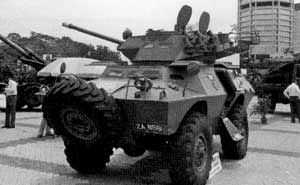 |
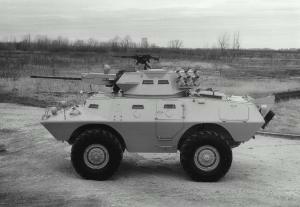 |
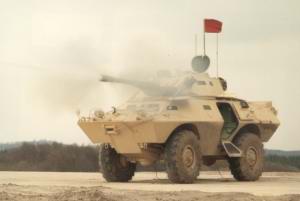 |
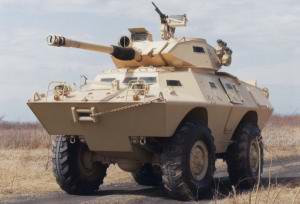 |
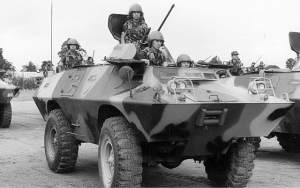 |
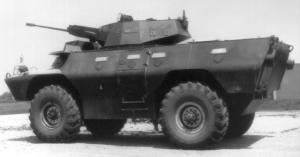 |
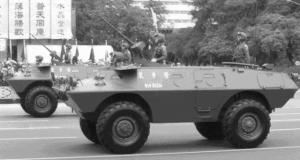 |
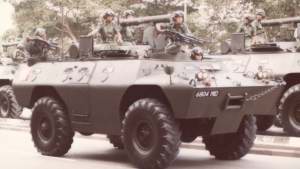 |
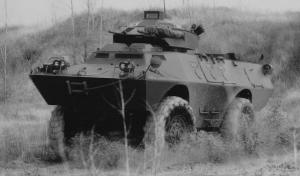 |
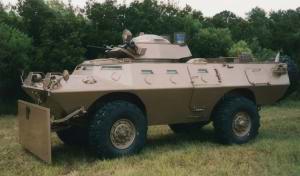 |



















